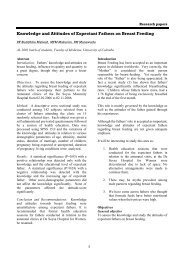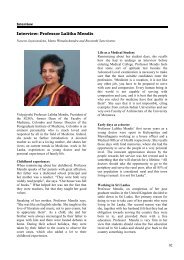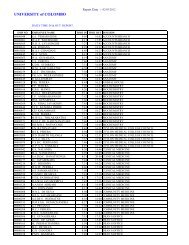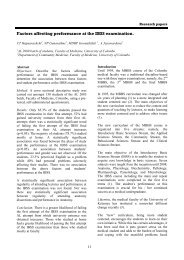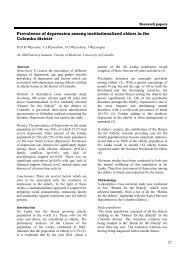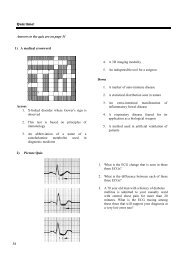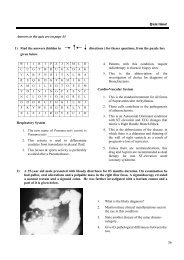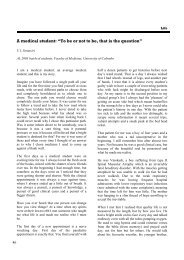Choosing the correct statistical test made easy - Faculty of Medicine ...
Choosing the correct statistical test made easy - Faculty of Medicine ...
Choosing the correct statistical test made easy - Faculty of Medicine ...
You also want an ePaper? Increase the reach of your titles
YUMPU automatically turns print PDFs into web optimized ePapers that Google loves.
categorization also provides information on <strong>the</strong><br />
relationship between <strong>the</strong>m. In experimental studies<br />
we may use ordinal scale to categorize study units<br />
in both experimental and control groups based on<br />
<strong>the</strong> type <strong>of</strong> response that <strong>the</strong>y will experience<br />
following administering <strong>of</strong> a drug using <strong>the</strong><br />
categories such as ‘very good response’, ‘good<br />
response’ and ‘poor response’. Again, this<br />
categorization provides information on <strong>the</strong><br />
relationship between categories. It indicates that<br />
‘very good response’ would be better than ‘good<br />
response’ and ‘good response’ would be better<br />
than ‘poor response’. However, it should be noted<br />
that ordinal scale does not numerically quantify<br />
how much greater ‘very good response’ is<br />
compared to ‘good response’. Results <strong>of</strong> research<br />
data measured in ordinal scale would be presented<br />
using frequency distributions.<br />
Interval scale: When <strong>the</strong> researcher assigns<br />
numbers to observations, if <strong>the</strong> difference<br />
(interval) between two such numbers that are<br />
assigned is meaningful (numbers are assigned to<br />
weigh observations/measurements and <strong>the</strong><br />
difference between two such<br />
observations/measurements will denote how much<br />
‘greater than’ or ‘lesser than’ one measure is from<br />
<strong>the</strong> o<strong>the</strong>r), this scale <strong>of</strong> measurement is called<br />
interval scale. In interval scale <strong>the</strong> number we<br />
assign each observation/measurement represents<br />
<strong>the</strong> actual magnitude <strong>of</strong> it. The distances between<br />
successive points in an interval scale are equal.<br />
In descriptive studies we may measure heights <strong>of</strong><br />
individuals and assign <strong>the</strong>m values in <strong>the</strong> interval<br />
scale using <strong>the</strong> unit centimetre (cm). A person who<br />
is assigned <strong>the</strong> number 150 cm we know is taller<br />
than <strong>the</strong> person assigned <strong>the</strong> number 140 cm and<br />
we also know that <strong>the</strong> difference <strong>of</strong> height between<br />
<strong>the</strong>se two persons is 10 cm. In experimental<br />
studies we may use <strong>the</strong> interval scale to measure<br />
<strong>the</strong> response to a drug among study units in both<br />
experimental and control groups in terms <strong>of</strong><br />
improvement <strong>of</strong> Haemoglobin level. We would<br />
<strong>the</strong>n know that a person who has an improvement<br />
<strong>of</strong> 3 g/dl had responded to <strong>the</strong> drug better than a<br />
person who had an improvement <strong>of</strong> 1 g/dl and that<br />
<strong>the</strong> difference <strong>of</strong> improvement is 2 g/dl. We also<br />
know that <strong>the</strong> difference between two persons; one<br />
with 2 g/dl improvement and one with 3 g/dl<br />
improvement (i.e.: 1 g/dl) is equal to <strong>the</strong> difference<br />
between ano<strong>the</strong>r two persons; one with 4 g/dl<br />
improvement and <strong>the</strong> o<strong>the</strong>r with 5 g/dl<br />
improvement.<br />
Results <strong>of</strong> research data measured in interval scale<br />
would be presented using measures <strong>of</strong> central<br />
tendency (mean, mode, median) and dispersion<br />
(standard deviation, standard error).<br />
At this stage, when we have determined <strong>the</strong> type <strong>of</strong><br />
<strong>the</strong> scale that has been used to measure <strong>the</strong><br />
outcome that has to be <strong>statistical</strong>ly <strong>test</strong>ed, we can<br />
make some decisions regarding <strong>the</strong> collective<br />
group <strong>of</strong> <strong>statistical</strong> <strong>test</strong>s that we may use (Table 1).<br />
Table 1: Groups <strong>of</strong> <strong>statistical</strong> <strong>test</strong>s to be used for data<br />
Nominal<br />
Ordinal<br />
Interval<br />
measured using different scales <strong>of</strong> measurement<br />
Chi-square or one <strong>of</strong> its variation<br />
Ordinal <strong>test</strong>s / non-parametric <strong>test</strong>s<br />
(U,H,T, Spearmen r)<br />
Is <strong>the</strong><br />
measure<br />
normally<br />
distributed<br />
in <strong>the</strong><br />
population?<br />
YES - parametric<br />
<strong>test</strong>s (t, F, Pearson r)<br />
NO – consider data<br />
as being measured<br />
in <strong>the</strong> ordinal scale.<br />
Use ordinal <strong>test</strong>s /<br />
non-parametric <strong>test</strong>s<br />
(U,H,T, Spearmen r)<br />
As shown above, when <strong>the</strong> scales <strong>of</strong> measurements<br />
are ei<strong>the</strong>r nominal or ordinal, <strong>the</strong> groups <strong>of</strong><br />
<strong>statistical</strong> <strong>test</strong>s to be used can be decided without<br />
answering any fur<strong>the</strong>r question. In case <strong>of</strong> interval<br />
scale, we need to answer a fur<strong>the</strong>r question which<br />
inquires whe<strong>the</strong>r or not <strong>the</strong> measure is normally<br />
distributed in <strong>the</strong> population. The normally<br />
distributed measures will conform to a normal<br />
curve if we do this measurement on <strong>the</strong> whole<br />
population and plot a graph with values <strong>of</strong> <strong>the</strong><br />
measurement presented in <strong>the</strong> X axis and<br />
frequency <strong>of</strong> occurrence presented in <strong>the</strong> Y axis.<br />
The normal curve as Gauss described it (also<br />
known as <strong>the</strong> Gaussian curve) is actually a<br />
<strong>the</strong>oretical distribution. The good news for<br />
researchers is that many human related<br />
measurements we perform such as weight and<br />
height come close to this ideal distribution. As<br />
shown in Table 1, if a search <strong>of</strong> <strong>the</strong> body <strong>of</strong><br />
literature indicates that <strong>the</strong> measure is normally<br />
distributed in <strong>the</strong> population, <strong>the</strong> researcher should<br />
make <strong>the</strong> decision to use one <strong>of</strong> <strong>the</strong> parametric<br />
<strong>statistical</strong> <strong>test</strong>s to <strong>test</strong> for significance. If it is found<br />
that <strong>the</strong> measure that <strong>the</strong> researcher is dealing with<br />
34



